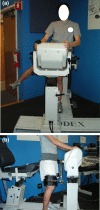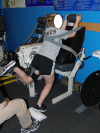Reduced hip strength is associated with increased hip motion during running in young adult and adolescent male long-distance runners
- PMID: 25133074
- PMCID: PMC4127508
Reduced hip strength is associated with increased hip motion during running in young adult and adolescent male long-distance runners
Abstract
Study design: Controlled laboratory study.
Background and purpose: Anterior knee pain is one of the most common running symptoms reported in the literature. While the exact etiology is unknown, a lack of hip strength is suggested to contribute to abnormal running mechanics. The purpose of this research study was to evaluate the association between isokinetic hip strength and 3-D running kinematics.
Methods: 33 male high school and collegiate cross country runners participated in this study. Peak isokinetic hip abductor and hip extensor strength were assessed. Each subject also completed a treadmill running protocol at a self-selected speed (mean = 3.8 m/s). 3-D kinematic data were collected at 240 Hz using a 10-camera motion capture system. Pearson correlation coefficients were used to determine the relationship between hip strength and hip range of motion (ROM) during the stance phase of running (p<0.05).
Results: Peak isokinetic hip extensor torque was inversely correlated with transverse plane hip ROM (r = -.387, p = .026) but was not significantly related to sagittal plane hip ROM or frontal plane hip ROM. Peak isokinetic hip abductor torque was inversely correlated with frontal plane hip ROM (r=-.462, p=.008) but was not significantly related to either sagittal plane hip ROM or transverse plane hip ROM. Peak isokinetic hip extensor torque and peak isokinetic hip abductor torque were not significantly related to knee kinematics in any plane.
Conclusions: Peak isokinetic hip extensor torque and peak isokinetic hip abductor torque are associated with transverse plane and frontal plane hip kinematics, but not knee kinematics.
Levels of evidence: Level 3b.
Keywords: cross country; hip strength; isokinetic testing; running biomechanics..
Figures





Similar articles
-
Relationship between hip strength and trunk motion in college cross-country runners.Med Sci Sports Exerc. 2013 Jun;45(6):1125-30. doi: 10.1249/MSS.0b013e3182825aca. Med Sci Sports Exerc. 2013. PMID: 23274608
-
Relationships between Running Biomechanics, Hip Muscle Strength, and Running-Related Injury in Female Collegiate Cross-country Runners.Int J Sports Phys Ther. 2022 Oct 1;17(6):1053-1062. doi: 10.26603/001c.38017. eCollection 2022. Int J Sports Phys Ther. 2022. PMID: 36237650 Free PMC article.
-
Effects of anti-pronation shoes on lower limb kinematics and kinetics in female runners with pronated feet: The role of physical fatigue.PLoS One. 2019 May 14;14(5):e0216818. doi: 10.1371/journal.pone.0216818. eCollection 2019. PLoS One. 2019. PMID: 31086402 Free PMC article.
-
Position- and Sex-Related Differences in Sagittal and Frontal Plane Concentric Isokinetic Hip Muscle Peak Torques and Agonist-Antagonist Ratios.Int J Sports Phys Ther. 2024 Nov 2;19(11):1407-1416. doi: 10.26603/001c.124117. eCollection 2024. Int J Sports Phys Ther. 2024. PMID: 39502543 Free PMC article.
-
Fatigue matters: An intense 10 km run alters frontal and transverse plane joint kinematics in competitive and recreational adult runners.Gait Posture. 2020 Feb;76:277-283. doi: 10.1016/j.gaitpost.2019.11.016. Epub 2019 Dec 13. Gait Posture. 2020. PMID: 31884254
Cited by
-
Unveiling the influence of hip isokinetic strength on lower extremity running kinematics in male national middle-distance runners: a correlational analysis.BMC Sports Sci Med Rehabil. 2024 Jul 19;16(1):157. doi: 10.1186/s13102-024-00946-x. BMC Sports Sci Med Rehabil. 2024. PMID: 39030608 Free PMC article.
-
Concurrent validity and reliability of 2d kinematic analysis of frontal plane motion during running.Int J Sports Phys Ther. 2015 Apr;10(2):136-46. Int J Sports Phys Ther. 2015. PMID: 25883862 Free PMC article.
-
INTER- AND INTRA-RATER RELIABILITY OF PERFORMANCE MEASURES COLLECTED WITH A SINGLE-CAMERA MOTION ANALYSIS SYSTEM.Int J Sports Phys Ther. 2017 Aug;12(4):520-526. Int J Sports Phys Ther. 2017. PMID: 28900557 Free PMC article.
-
ALTERED SAGITTAL PLANE HIP BIOMECHANICS IN ADOLESCENT MALE DISTANCE RUNNERS WITH A HISTORY OF LOWER EXTREMITY INJURY.Int J Sports Phys Ther. 2018 Jun;13(3):441-452. Int J Sports Phys Ther. 2018. PMID: 30038830 Free PMC article.
-
Fatigue Induced Changes in Muscle Strength and Gait Following Two Different Intensity, Energy Expenditure Matched Runs.Front Bioeng Biotechnol. 2020 Apr 22;8:360. doi: 10.3389/fbioe.2020.00360. eCollection 2020. Front Bioeng Biotechnol. 2020. PMID: 32391353 Free PMC article.
References
-
- National Federation of High Schools survey of participation. Available at: http://www.nfhs.org/Participation/ Accessed July 3
-
- Rauh MJ Koepsell TD Rivara FP et al. Epidemiology of musculoskeletal injuries among high school cross‐country runners. Am J Epidemiol. 2006;163:151‐9 - PubMed
-
- Souza RB Powers CM Predictors of hip internal rotation during running: an evaluation of hip strength and femoral structure in women with and without patellofemoral pain. Am J Sports Med. 2009;37:579‐87 - PubMed
LinkOut - more resources
Full Text Sources
Research Materials
